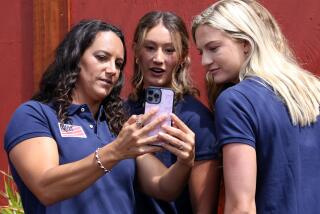Polo for Populists : Pickup Matches in Moorpark Lower Hurdles to the Sport for Beginners and Old Pros
- Share via
MOORPARK
Pickup polo isn’t quite like a shirts-and-skins basketball game, but at MoorpH Polo Farms it comes pretty close.
The come-as-you-are, three-times-a-week matches are a far cry from the brutal and expensive game of princes that most people think of when they think of polo.
Each week, a broad mix of riders ranging from construction workers to dentists to professional polo players drop by for a chance to run their horses--or horse--and engage in polo combat.
They divide up into two teams, suit up and go at it. Typically, they might play four to eight seven-minute periods, known as chukkers.
“It’s not about what you’re wearing or even how good you are. We’re just out here to have fun,” said Billy Stephenson, 27, a Camarillo construction worker who has been playing the sport for two years.
“Once you play, it’s easy to get hooked on it,” Stephenson said.
The Moorpark club is run by Sue Sally Hale, a pioneer in women’s polo.
Hale, 57, once was the highest-ranked women’s polo player in the world. Now, her daughter, Sunny Hale, 26, holds that distinction.
For years, Hale had to disguise herself as a man just for a chance to play the game. But in 1972 she was finally accepted into the U.S. Polo Assn., becoming a sort of grande dame of the sport.
Ever since then she has been opening opportunities. Not just for women, but also for others who have been locked out of the clubby world of polo.
At H & H, Hale and another of her daughters, Stormie Hale, 30, teach polo to anyone who’s willing to plunk down the $20 an hour it costs for lessons.
“They’re wonderful teachers,” said Lynn Wan, a children’s dentist from Camarillo who first came out to the ranch with her sister two years ago.
Still a bit tentative in her approach, Wan was willing to ride her horse into the fray and challenge other riders for the ball.
During a friendly match one day last week, Wan kicked her horse into a quick trot as she chased after the ball, with several riders in hot pursuit.
“Look at her go for the ball,” said a proud Sue Sally Hale. “She didn’t even know how to ride when she first came here. Now look at her.”
Most of the novice riders said overcoming their fear was the biggest challenge--polo, after all, is a thrill sport.
In traditional matches, riders often gallop down the field with their mallets raised like ancient warriors.
Domingo Questal, 40, a professional player from Moorpark, lost an eye in his first year of play.
With his eye patch and string of taut polo ponies, he seems to add an air of professionalism to the games held on H & H’s divot-covered field, which is about a third of the size of a regulation field.
Questal comes to play at H & H to keep his ponies fit, and to play polo with his 11-year-old son, Manuel.
“I like coming here,” he said. “It’s good practice.”
Questal, Hale and a few other gifted players help keep the flow of the game going as the beginners try to keep up. They pipe in with helpful advice, and warn off riders who are playing too aggressively. Crossing into the path of another rider is a foul, as is hitting another player’s raised mallet.
Most beginners are careful at first--a fall from a galloping horse can be quite painful. Sprains, strains and broken bones are not too unusual in the physically demanding sport.
Glistening with a fine sheen of sweat after a match, Dori Sill, a 35-year-old massage therapist from Toluca Lake, said the two seven-minute chukkers she played were enough activity for the day.
“It’s a whole-body workout,” Sill said as she tried to catch her breath. “It’s a lot quicker than tennis.”
The ponies probably get the toughest workout. Most are thin and stripped with muscles from running dozens of miles every week. When they’re not playing, the ponies are run around a track to keep them in shape. To keep the horses from being injured, none plays more than two chukkers a day.
The horses must also be fearless, said Marshall Allen, a 49-year-old periodontist from Somis. Allen plays polo at least four times a week to maintain his abundant skills.
“You have to play them almost every day to keep them fit in the body and brain,” he said.
The horses must be willing to charge into a galloping pack and trust the riders’ instructions. If a horse doesn’t have the heart for polo, it can’t be forced into playing, Allen said. That is one of the reasons a good polo horse can cost more than $15,000--adequate mounts can be had for as little as $3,500.
The expense doesn’t stop there. If the owner does not have a stable, the cost of having someone groom, feed, shoe and board the horse can be up to $5,000 a year.
At H & H, riders can rent a horse for about $40 an hour, but other clubs often charge much more. In addition, club memberships can run anywhere from $3,000 a year to about $18,000. H & H does not charge a membership fee, because it is meant be a training ground for enthusiasts to learn the sport.
“No, we don’t charge a fee, but you have to play by my rules,” Hale said. “You have to play correctly. We don’t let people ride so hard that they kill their horses. . . . And you have to have fun.”
More to Read
Go beyond the scoreboard
Get the latest on L.A.'s teams in the daily Sports Report newsletter.
You may occasionally receive promotional content from the Los Angeles Times.










